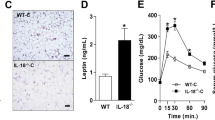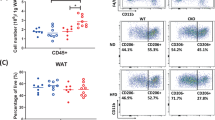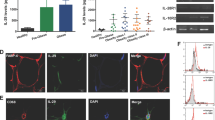Abstract
Background:
Adipose tissue expansion during obesity is associated with a state of low-grade inflammation and an increase in macrophage infiltration, which predisposes to insulin resistance and vascular malfunction. Growing evidence suggests that vitamin D3 has immunoregulatory effects and adipose tissue could be a target for vitamin D3 action. Preadipocytes, one of the major cell types in adipose tissue, are actively involved in inflammatory processes.
Objectives:
This study investigated whether the active form of vitamin D3 (1,25(OH)2D3) affects the production of proinflammatory chemokines/cytokines and the monocyte recruitment by human preadipocytes.
Methods/results:
The secretion levels of monocyte chemoattractant proteint-1 (MCP-1), IL-8 and IL-6 were significantly higher in preadipocytes than in differentiated adipocytes, suggesting that preadipocytes could be a major source of proinflammatory mediators. Cytokine profile analysis revealed that 1,25(OH)2D3 (10 nM) markedly reduced the release of MCP-1, IL-6 and IL-8 by preadipocytes. The involvement of NFκB signalling was shown by the upregulation of IκBα protein abundance by 1,25(OH)2D3 in preadipocytes. In addition, 1,25(OH)2D3 was able to decrease the migration of THP-1 monocytes. Treatment with proinflammatory stimuli, including macrophage-conditioned (MC) medium, TNFα and IL-1β, led to a marked increase in protein release of MCP-1 and IL-6 by preadipocytes. Pretreatment with 1,25(OH)2D3 (10 nM and 100 nM) significantly decreased the stimulatory effects of MC medium, TNFα and IL-1β on MCP-1 expression and protein release, although the effect on stimulated release of IL-6 was less potent.
Conclusions:
These results demonstrate that 1,25(OH)2D3 decreases the production of MCP-1 and other proinflammatory mediators by preadipocytes and reduces monocyte migration. Thus, vitamin D3 may protect against adipose tissue inflammation by disrupting the deleterious cycle of macrophage recruitment.
This is a preview of subscription content, access via your institution
Access options
Subscribe to this journal
Receive 12 print issues and online access
$259.00 per year
only $21.58 per issue
Buy this article
- Purchase on Springer Link
- Instant access to full article PDF
Prices may be subject to local taxes which are calculated during checkout






Similar content being viewed by others
References
Weisberg SP, McCann D, Desai M, Rosenbaum M, Leibel RL, Ferrante AW . Obesity is associated with macrophage accumulation in adipose tissue. J Clin Invest 2003; 112: 1796–1808.
Xu H, Barnes GT, Yang Q, Tan G, Yang D, Chou CJ et al. Chronic inflammation in fat plays a crucial role in the development of obesity-related insulin resistance. J Clin Invest 2003; 112: 1821–1830.
Trayhurn P, Wood IS . Adipokines: inflammation and the pleiotropic role of white adipose tissue. Br J Nutr 2004; 92: 347–355.
Hotamisligil GS, Arner P, Caro JF, Atkinson RL, Spiegelman BM . Increased adipose tissue expression of tumor necrosis factor-alpha in human obesity and insulin resistance. J Clin Invest 1995; 95: 2409–2415.
Fontana L, Eagon JC, Trujillo ME, Scherer PE, Klein S . Visceral fat adipokine secretion is associated with systemic inflammation in obese humans. Diabetes 2007; 56: 1010–1013.
Skurk T, Alberti-Huber C, Herder C, Hauner H . Relationship between adipocyte size and adipokine expression and secretion. J Clin Endocrinol Metab 2007; 92: 1023–1033.
Fain JN . Release of inflammatory mediators by human adipose tissue is enhanced in obesity and primarily by the nonfat cells: a review. Mediators Inflamm 2010; 2010: 513948.
Cousin B, Munoz O, Andre M, Fontanilles AM, Dani C, Cousin JL et al. A role for preadipocytes as macrophage-like cells. FASEB J 1999; 13: 305–312.
Lacasa D, Taleb S, Keophiphath M, Miranville A, Clement K . Macrophage-secreted factors impair human adipogenesis: involvement of proinflammatory state in preadipocytes. Endocrinology 2007; 148: 868–877.
Gao D, Bing C . Macrophage-induced expression and release of matrix metalloproteinase 1 and 3 by human preadipocytes is mediated by IL-1β via activation of MAPK signalling. J Cell Physiol 2011.
Verstuyf A, Carmeliet G, Bouillon R, Mathieu C . Vitamin D: a pleiotropic hormone. Kidney Int 2010; 78: 140–145.
Hewison M . Vitamin D and immune function: an overview. Proc Nutr Soc 2012; 71: 50–61.
Moreno J, Krishnan AV, Swami S, Nonn L, Peehl DM, Feldman D . Regulation of prostaglandin metabolism by calcitriol attenuates growth stimulation in prostate cancer cells. Cancer Res 2005; 65: 7917–7925.
Krishnan AV, Swami S, Feldman D . Vitamin D and breast cancer: inhibition of estrogen synthesis and signaling. J Steroid Biochem Mol Biol 2010; 121: 343–348.
Nonn L, Peng L, Feldman D, Peehl DM . Inhibition of p38 by vitamin D reduces interleukin-6 production in normal prostate cells via mitogen-activated protein kinase phosphatase 5: implications for prostate cancer prevention by vitamin D. Cancer Res 2006; 66: 4516–4524.
Yu XP, Bellido T, Manolagas SC . Down-regulation of NF-kappa B protein levels in activated human lymphocytes by 1,25-dihydroxyvitamin D3 . Proc Natl Acad Sci USA 1995; 92: 10990–10994.
Harant H, Wolff B, Lindley IJ . 1Alpha,25-dihydroxyvitamin D3 decreases DNA binding of nuclear factor-kappaB in human fibroblasts. FEBS Lett 1998; 436: 329–334.
Stio M, Martinesi M, Bruni S, Treves C, Mathieu C, Verstuyf A et al. The vitamin D analogue TX 527 blocks NF-kappaB activation in peripheral blood mononuclear cells of patients with Crohn's disease. J Steroid Biochem Mol Biol 2007; 103: 51–60.
Rajakumar K, Fernstrom JD, Holick MF, Janosky JE, Greenspan SL . Vitamin D status and response to Vitamin D(3) in obese vs. non-obese African American children. Obesity (Silver Spring) 2008; 16: 90–95.
Brock K, Huang WY, Fraser DR, Ke L, Tseng M, Stolzenberg-Solomon R et al. Low vitamin D status is associated with physical inactivity, obesity and low vitamin D intake in a large US sample of healthy middle-aged men and women. J Steroid Biochem Mol Biol 2010; 121: 462–466.
Cheng S, Massaro JM, Fox CS, Larson MG, Keyes MJ, McCabe EL et al. Adiposity, cardiometabolic risk, and vitamin D status: the Framingham Heart Study. Diabetes 2010; 59: 242–248.
Rajakumar K, de las Heras J, Chen TC, Lee S, Holick MF, Arslanian SA . Vitamin D status, adiposity, and lipids in black American and Causasian children. J Clin Endocrinol Metab 2011; 96: 1560–1567.
Peterson CA, Heffernan ME . Serum tumor necrosis factor-alpha concentrations are negatively correlated with serum 25(OH)D concentrations in healthy women. J Inflamm (Lond) 2008; 5: 10.
Kong J, Li YC . Molecular mechanism of 1,25-dihydroxyvitamin D3 inhibition of adipogenesis in 3T3-L1 cells. Am J Physiol Endocrinol Metab 2006; 290: E916–E924.
Zhuang H, Lin Y, Yang G . Effects of 1,25-dihydroxyvitamin D3 on proliferation and differentiation of porcine preadipocyte in vitro. Chem Biol Interact 2007; 170: 114–123.
Lorente-Cebrian S, Eriksson A, Dunlop T, Mejhert N, Dahlman I, Astrom G et al. Differential effects of 1α,25-dihydroxycholecalciferol on MCP-1 and adiponectin production in human white adipocytes. Eur J Nutr 2012; 51: 335–342.
Bao Y, Bing C, Hunter L, Jenkins JR, Wabitsch M, Trayhurn P . Zinc-alpha2-glycoprotein a lipid mobilizing factor, is expressed and secreted by human (SGBS) adipocytes. FEBS Lett 2005; 579: 41–47.
Wang B, Wood IS, Trayhurn P . Hypoxia induces leptin gene expression and secretion in human preadipocytes: differential effects of hypoxia on adipokine expression by preadipocytes. J Endocrinol 2008; 198: 127–134.
Schmittgen TD, Livak KJ . Analyzing real-time PCR data by the comparative C(T) method. Nat Protoc 2008; 3: 1101–1108.
Pantanetti P, Garrapa GG, Mantero F, Boscaro M, Faloia E, Venarucci D . Adipose tissue as an endocrine organ? A review of recent data related to cardiovascular complications of endocrine dysfunctions. Clin Exp Hypertens 2004; 26: 387–398.
Chung S, Lapoint K, Martinez K, Kennedy A, Boysen Sandberg M, McIntosh MK . Preadipocytes mediate lipopolysaccharide-induced inflammation and insulin resistance in primary cultures of newly differentiated human adipocytes. Endocrinology 2006; 147: 5340–5351.
Charriere G, Cousin B, Arnaud E, Andre M, Bacou F, Penicaud L et al. Preadipocyte conversion to macrophage. Evidence of plasticity. J Biol Chem 2003; 278: 9850–9855.
Zhang Y, Leung DY, Richers BN, Liu Y, Remigio LK, Riches DW et al. Vitamin D inhibits monocyte/macrophage proinflammatory cytokine production by targeting MAPK phosphatase-1. J Immunol 2012; 188: 2127–2135.
Ching S, Kashinkunti S, Niehaus MD, Zinser GM . Mammary adipocytes bioactivate 25-hydroxyvitamin D and signal via vitamin D receptor, modulating mammary epithelial cell growth. J Cell Biochem 2011; 112: 3393–3405.
Hewison M . Antibacterial effects of vitamin D. Nat Rev Endocrinol 2011; 7: 337–345.
Weisberg SP, Hunter D, Huber R, Lemieux J, Slaymaker S, Vaddi K et al. CCR2 modulates inflammatory and metabolic effects of high-fat feeding. J Clin Invest 2006; 116: 115–124.
Sartipy P, Loskutoff DJ . Monocyte chemoattractant protein 1 in obesity and insulin resistance. Proc Natl Acad Sci USA 2003; 100: 7265–7270.
Gao D, Trayhurn P, Bing C . Macrophage-secreted factors inhibit ZAG expression and secretion by human adipocytes. Mol Cell Endocrinol 325: 135–142.
Waugh DJ, Wilson C . The interleukin-8 pathway in cancer. Clin Cancer Res 2008; 14: 6735–6741.
Bruun JM, Lihn AS, Madan AK, Pedersen SB, Schiott KM, Fain JN et al. Higher production of IL-8 in visceral vs. subcutaneous adipose tissue. Implication of nonadipose cells in adipose tissue. Am J Physiol Endocrinol Metab 2004; 286: E8–13.
Elgazar-Carmon V, Rudich A, Hadad N, Levy R . Neutrophils transiently infiltrate intra-abdominal fat early in the course of high-fat feeding. J Lipid Res 2008; 49: 1894–1903.
Keophiphath M, Achard V, Henegar C, Rouault C, Clement K, Lacasa D . Macrophage-secreted factors promote a profibrotic phenotype in human preadipocytes. Mol Endocrinol 2009; 23: 11–24.
Bonizzi G, Karin M . The two NF-kappaB activation pathways and their role in innate and adaptive immunity. Trends Immunol 2004; 25: 280–288.
Cohen-Lahav M, Shany S, Tobvin D, Chaimovitz C, Douvdevani A . Vitamin D decreases NFkappaB activity by increasing IkappaBalpha levels. Nephrol Dial Transplant 2006; 21: 889–897.
Zhang Z, Yuan W, Sun L, Szeto FL, Wong KE, Li X et al. 1,25-Dihydroxyvitamin D3 targeting of NF-kappaB suppresses high glucose-induced MCP-1 expression in mesangial cells. Kidney Int 2007; 72: 193–201.
Jones G . Pharmacokinetics of vitamin D toxicity. Am J Clin Nutr 2008; 88: 582S–586S.
Cinti S, Mitchell G, Barbatelli G, Murano I, Ceresi E, Faloia E et al. Adipocyte death defines macrophage localization and function in adipose tissue of obese mice and humans. J Lipid Res 2005; 46: 2347–2355.
Lumeng CN, Deyoung SM, Bodzin JL, Saltiel AR . Increased inflammatory properties of adipose tissue macrophages recruited during diet-induced obesity. Diabetes 2007; 56: 16–23.
Giulietti A, van Etten E, Overbergh L, Stoffels K, Bouillon R, Mathieu C . Monocytes from type 2 diabetic patients have a pro-inflammatory profile. 1,25-Dihydroxyvitamin D(3) works as anti-inflammatory. Diabetes Res Clin Pract 2007; 77: 47–57.
Acknowledgements
We thank Professor Helen R Griffiths (Aston University, UK) for providing the human THP-1 monocytes. We also thank Dr Adrian O'Hara for IL-1β neutralising antibody. This work was supported by the UK Medical Research Council (G0801226).
Author information
Authors and Affiliations
Corresponding author
Ethics declarations
Competing interests
The authors declare no conflict of interest.
Additional information
Supplementary Information accompanies the paper on International Journal of Obesity website
Supplementary information
Rights and permissions
About this article
Cite this article
Gao, D., Trayhurn, P. & Bing, C. 1,25-Dihydroxyvitamin D3 inhibits the cytokine-induced secretion of MCP-1 and reduces monocyte recruitment by human preadipocytes. Int J Obes 37, 357–365 (2013). https://doi.org/10.1038/ijo.2012.53
Received:
Revised:
Accepted:
Published:
Issue Date:
DOI: https://doi.org/10.1038/ijo.2012.53
Keywords
This article is cited by
-
Relationship between vitamin D status in the first trimester of the pregnancy and gestational weight gain: a mediation analysis
Archives of Gynecology and Obstetrics (2022)
-
Inflammatory Cross-Talk Between Short Sleep Duration and Obesity in Development of Insulin Resistance: Narrative Review
Sleep and Vigilance (2020)
-
1α,25(OH)2D3 attenuates IL-6 and IL-1β-mediated inflammatory responses in macrophage conditioned medium-stimulated human white preadipocytes by modulating p44/42 MAPK and NF-κB signaling pathways
Diabetology & Metabolic Syndrome (2019)
-
Serum 25-hydroxyvitamin D and cardiovascular disease risk factors in women with excessive weight gain during pregnancy and in their offspring at age 5–6 years
International Journal of Obesity (2018)
-
Is there any link between tumor-induced osteomalacia and psoriasis? A case report
Journal of Diabetes & Metabolic Disorders (2017)



